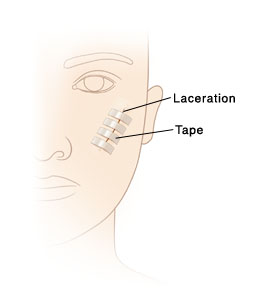Face Laceration: Stitches or Tape
A laceration is a cut through the skin. This may require stitches if it is deep. Minor cuts may be treated with surgical tape.

Home care
-
Follow all instructions for any prescribed medicines.
-
Your healthcare provider may prescribe an antibiotic. This is to help prevent infection. Take the medicine every day until it's gone—even if you feel better—or you are told to stop. You should not have any left over.
-
The healthcare provider may prescribe medicines for pain. Take them as directed. If your provider did not prescribe pain medicine, you may use over-the-counter pain medicine. If you have chronic liver or kidney disease, or ever had a stomach ulcer or gastrointestinal bleeding, talk with your provider before using these medicines.
-
Follow the healthcare provider’s instructions on how to care for the cut.
-
Wash your hands with soap and clean, running water before and after caring for the cut. This helps prevent infection.
-
If a bandage was applied and it becomes wet or dirty, replace it. Otherwise, leave it in place for the first 24 hours, then change it once a day or as directed.
-
If stitches were used, clean the wound daily:
-
After removing the bandage, wash the area with soap and water. Use a clean, wet cotton swab to loosen and remove any blood or crust that forms.
-
After cleaning, keep the wound clean and dry. Talk with your healthcare provider before putting any antibiotic ointment on the wound. Reapply a fresh bandage.
-
Remove the bandage to shower as usual after the first 24 hours, but don't soak the area in water (no swimming) until the stitches are removed.
-
If surgical tape was used, keep the area clean and dry. If it becomes wet, blot it dry with a towel.
-
While the stitches or tape are in place, keep the wound out of prolonged direct sunlight. After the stitches or tape are removed, continue to stay out of direct sunlight for the next 6 to 12 months, or use a sunscreen with a high level of protection. Sunburn or sun exposure can increase scarring.
-
Most facial skin wounds heal without problems. But an infection sometimes occurs despite proper treatment. Watch for the signs of infection listed below.
Follow-up care
Follow up with your healthcare provider as advised. Ask your provider how long stitches should remain in place. Be sure to return for removal of the stitches as directed. This is usually within 5 to 7 days. If surgical tape closures were used, you may remove them yourself when your provider recommends if they have not fallen off on their own.
When to get medical advice
Call your healthcare provider right away if any of these occur:
-
Wound bleeding that's not controlled by direct pressure
-
Signs of infection. These include increasing pain in the wound, increasing wound redness or swelling, or pus or bad odor coming from the wound.
-
Fever of 100.4°F (38ºC) or higher, or as directed by your healthcare provider
-
Chills
-
Stitches coming apart or falling out or surgical tape falling off before 5 days
-
Wound edges reopening
-
Wound color changes
-
Numbness around the wound
Online Medical Reviewer:
Eric Perez MD
Online Medical Reviewer:
Ronald Karlin MD
Online Medical Reviewer:
Tara Novick BSN MSN
Date Last Reviewed:
12/1/2022
© 2000-2024 The StayWell Company, LLC. All rights reserved. This information is not intended as a substitute for professional medical care. Always follow your healthcare professional's instructions.